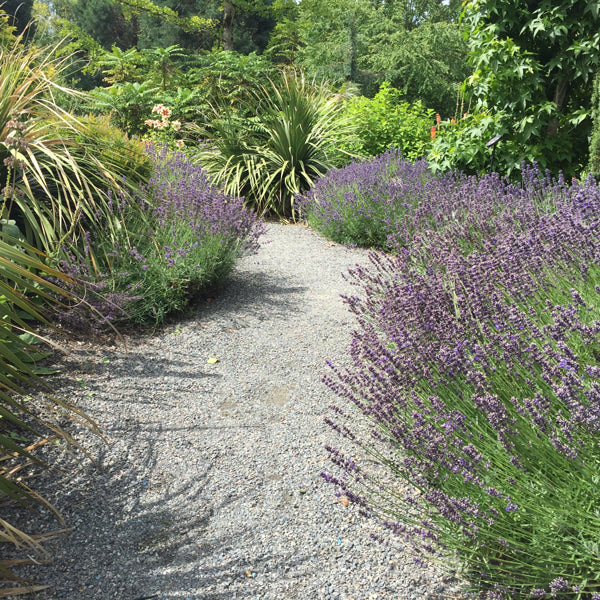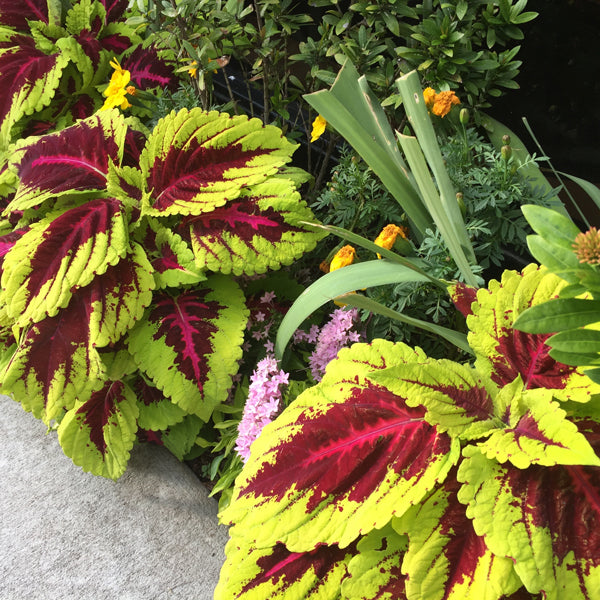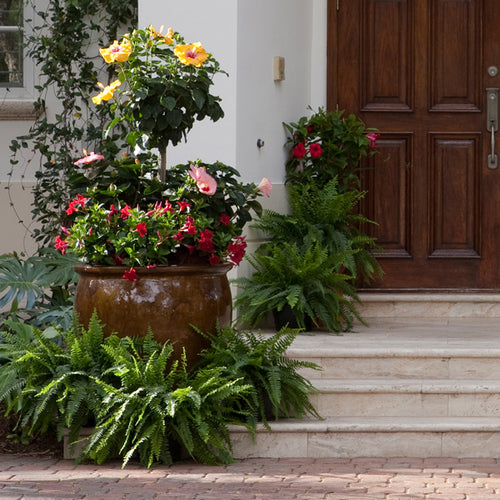
Combine Annuals and Perennials
Enjoy the best of both worlds when you edge a walkway with a mix of low-growing annual and perennial plants. The annuals will provide non-stop color from spring to fall while the perennials add reliable interest and color year after year.Here, clumps of white sweet alyssum were interplanted between drifts of the gray-green foliage of lamb’s ear. Both plants remain under 12 inches tall which makes this the perfect team to edge a winding brick path.

Use Your Favorite Color Palette
When you visit the garden center, it’s always tempting to buy one of everything. After all, every plant is lovely in its own way. Instead, focus only on flowers in your favorite color palette. That way, the end result will be a pleasing mix of colors that will look like it was designed by an expert (YOU!)Along this stepping stone pathway, pink and gray reign supreme with pink wax begonias, pink dwarf yarrow, and gray-leaf licorice plant.

Mass in Color Blocks
When it comes to flowers, there’s no such thing as too much of a good thing. In fact, sometimes you’ll get the best effect from simply massing one plant along your garden walkways.Here, for example, the ever-blooming 'Stella d’Oro' daylily creates a colorful and reliable low hedge that’s so bright you can even see it after the sun goes down. This popular daylily grows just 24 inches tall and forms such thick clumps that even the toughest weeds can’t break through.

Don't Forget Fragrance
There’s nothing more relaxing than strolling down a garden path that’s as fragrant as it is colorful. Plants such as thyme, lavender, mint, scented geranium, and lemon balm are all low growers that release their delightful fragrances whenever you lightly brush by them.In this garden, a mass of lavender beautifully flanks a gravel path. On a warm sunny afternoon, the color and perfume are almost intoxicating. If you live where lavender isn’t winter hardy, substitute blue-flowering catmint instead.

Consider the Seasons
When selecting plants to edge your garden remember to include those that bloom later in the season when other plants slow down.Here, for example, the star of this border edge is a mass of fiery orange helenium also called sneezeweed (although it does not cause hayfever) teamed with a clump of Zebra grass and blue catmint. All three provide plenty of color from late summer through fall.

Go Bold in the Shade
Walks and paths in shady spots need a burst of bright color to make them pop. Impatiens, begonia, lamium, ajuga, hosta, and heuchera are just a few of the many colorful, low-growing plants you can choose from.In this garden, 'Kong' coleus holds court where it’s boldly patterned foliage lights the way down a dimly lit sidewalk. Coleus comes in an almost unlimited assortment of colors, shapes, and sizes so it’s easy to find one that fits your design style.

Include Pollinators in Your Plan
Just imagine walking through your garden and getting a close-up view of colorful butterflies. It’s easy when you add some nectar-rich flowers to your walkway’s edge.Here, a bold planting of Profusion yellow zinnias and purple verbena are as attractive to butterflies as they are to you. Both of these colorful annuals are packed with nectar that butterflies and moths will flock to.

Include Artwork
It doesn’t take much to make the simplest border something truly special. Strategically placed stones, driftwood, shells, or artwork that complements rather than competes with your plantings can make a huge impact.Along this sidewalk a mixed planting of low-growing hostas and blue flowering scabiosa becomes a traffic-stopping art installation with the simple installation of some stacked stones and a small slab of limestone. The key is to not go overboard, a few pieces is all you need--too many will look jumbled and distracting.

















